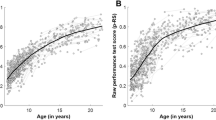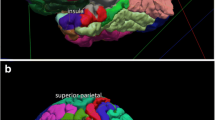Abstract
Background: The corpus callosum has been widely studied, but no study has demonstrated whether its size and shape have any relationship with language and calculation performance. Objective: To examine the morphometry of the corpus callosum of normal Chinese children and its relationship with gender and academic performance. Materials and methods: One hundred primary school children (63 boys, 37 girls; age 6.5–10 years) were randomly selected and the standardized academic performance for each was ascertained. On the mid-sagittal section of a brain MRI, the length, height and total area of the corpus callosum and its thickness at different sites were measured. These were correlated with sex and academic performance. Results: Apart from the normal average dimension of the different parts of the corpus callosum, thickness at the body-splenium junction in the average-to-good performance group was significantly greater than the below-average performance group in Chinese language (P=0.005), English language (P=0.02) and mathematics (P=0.01). The remainder of the callosal thickness showed no significant relationship with academic performance. There was no significant sex difference in the thickness of any part of the corpus callosum. Conclusions: These findings raise the suggestion that language and mathematics proficiency may be related to the morphometry of the fibre connections in the posterior parietal lobes.


Similar content being viewed by others
References
Zaidel D, Sperry RW (1977) Some long-term effects of cerebral commissurotomy in man. Neuropsychology 15:193–204
Zaidel D, Sperry RW (1974) Memory impairment after commissurotomy in man. Brain 97:263–272
Schaltenbrand G (1975) The effects on speech and language of stereotactical stimulation in thalamus and corpus callosum. Brain Lang 2:70–77
Giedd JN, Blumenthal J, Jeffries NO, et al (1999) Development of the human corpus callosum during childhood and adolescence: a longitudinal MRI study. Prog Neuropsychopharmacol Biol Psychiatry 23:571–588
Geschwind N (1965) Disconnection syndromes in animals and man. Brain 88:585–644
Howard D, Patterson K, Wise R, et al (1996) A chronic microelectrode investigation of the tonotopic organization of the human auditory cortex. Brain Res 734:260–264
Kawamura M, Hirayama K, Yamamoto H (1989) Different interhemispheric transfer of kanji and kana writing evidenced by a case with left unilateral agraphia without apraxia. Brain 112:1011–1018
Dubovsky EC, Booth TN, Vezina G, et al (2001) MR imaging of the corpus callosum in pediatric patients with neurofibromatosis type 1. AJNR 22:190–195
Iai M, Tanabe Y, Goto M, et al (1994) A comparative magnetic resonance imaging study of the corpus callosum in neurologically normal children and children with spastic diplegia. Acta Paediatr 83:1086–1090
Pozzilli C, Bastinanello S, Padovanni A, et al (1991) Anterior corpus callosum atrophy and verbal fluency in multiple sclerosis. Cortex 27:441–445
Gean-Marton AD, Vezina LG, Marton KI, et al (1991) Abnormal corpus callosum: a sensitive and specific indicator of multiple sclerosis. Radiology 180:215–221
Wang PP, Doherty S, Hesselink JR, et al (1992) Callosal morphology concurs with neurobehavioral and neuropathological findings in two neurodevelopmental disorders. Arch Neurol 49:407–411
DeLacoste MC, Kirkpatrick JB, Ross ED (1985) Topography of the human corpus callosum. J Neuropathol Exp Neurol 44:578–591
Hayakawa K, Konishi Y, Matsuda T, et al (1989) Development and aging of brain midline structures: assessment with MR imaging. Radiology 172:171–177
Georgy BA, Hesselink JR, Jernigan TL (1993) MR imaging of the corpus callosum. AJR 160:949–955
Yakovlev PI, Lecours AR (1967) The myelogenetic cycles of regional maturation of the brain. In: Minkowski A (ed) Regional development of the brain in early life. Blackwell Scientific, Oxford pp 3–70
Pujol J, Vendrell P, Junque C (1993) When does human brain development end? Evidence of corpus callosum growth up to adulthood. Ann Neurol 34:71–75
Rauch RA, Jinkins JR (1994) Analysis of cross-sectional area measurements of the corpus callosum adjusted for brain size in male and female subjects from childhood to adulthood. Behav Brain Res 64:65–78
De-Lacoste-Utamsing C, Holloway RL (1982) Sexual dimorphism in the human corpus callosum. Science 216:1431–1432
Pozzilli C, Bastianello S, Bozzao A, et al (1994) No differences in corpus callosum size by sex and aging. A quantitative study using magnetic resonance imaging. J Neuroimaging 4:218–221
Steinmetz H, Jancke L, Kleinschmidt A, et al (1992) Sex but no hand difference in the isthmus of the corpus callosum. Neurology 42:749–752
Halpern DF (2000) Sex differences in cognitive abilities. Erlbaum, Mahwah
Stumpf H, Stanley JC (1996) Gender-related differences on the College Boards’ Advanced Placement and Achievement Tests, 1982–1992. J Edu Psychol 88:353–364
Friedman L (1995) The space factor in mathematics: gender differences. Rev Educ Res 65:22–50
Halpern DF, LaMay ML (2000) The smarter sex: a critical review of sex differences in intelligence. Edu Psychol Rev 12:229–246
Weis S, Kimbacher M, Wenger E, et al (1993) Morphometric analysis of the corpus callosum using MR: correlation of measurements with aging in healthy individuals. AJNR 14:637–645
Sullivan EV, Rosenbloom MJ, Desmond JE (2001) Sex differences in corpus callosum size: relationship to age and intracranial size. Neurobiol Aging 22:603–611
Carpenter MB (1990) Core text of neuroanatomy, 4th edn. Williams and Wilkins, Baltimore, p 37
Barkovich AJ, Kjos BO (1988) Normal postnatal development of the corpus callosum as demonstrated by MR imaging. AJNR 9:487–491
Barkovich AJ, Norman D (1988) Anomalies of the corpus callosum: correlation with further anomalies of the brain. AJR 51:171–177
Geschwind N, Levitsky W (1968) Human brain: left-right asymmetry in temporal speech region. Science 161:186–187
Seltzer B, Pandya DN (1983) The distribution of posterior parietal fibers in the corpus callosum of the rhesus monkey. Exp Brain Res 49:147–150
Cipolloni PB, Pandya DN (1985) Topography and trajectories of commissural fibers of the superior temporal region in the rhesus monkey. Exp Brain Res 57:381–389
Egaas B, Courchesne E, Saitoh O (1995) Reduced size of corpus callosum in autism. Arch Neurol 52:794–801
Dehaene S, Spelke E, Pinel P, et al (1999) Sources of mathematical thinking: behavioral and brain-imaging evidence. Science 284:970–974
Pesenti M, Thioux M, Seron X, et al (2000) Neuroanatomical substrates of Arabic number processing, numerical comparison, and simple addition: a PET study. J Cogn Neurosci 12:461–79
Simon O, Mangin JF, Cohen L, et al (2002) Topographical layout of hand, eye, calculation, and language-related areas in the human parietal lobe. Neuron 33:475–487
Stanescu-Cosson R, Pinel P, van De Moortele PF, et al (2000) Understanding dissociations in dyscalculia: a brain imaging study of the impact of number size on the cerebral networks for exact and approximate calculation. Brain 123:2240–2255
LaMantia AS, Rakic P (1990) Cytological and quantitative characteristics of four cerebral commissures in the rhesus monkey. J Comp Neurol 291:520–537
Barkovich AJ (1995) Pediatric neuroimaging. Raven Press, New York, pp 9–52
Thompson PM, Giedd JN, Woods RP, et al (2000) Growth patterns in the developing brain detected by using continuum mechanical tensor maps. Nature 404:190–193
Allen LS, Richey MF, Chai YM, et al (1991) Sex differences in the corpus callosum of the living human being. J Neurosci 11:933–942
Clarke S, Kraftsik R, Van der Loos H, et al (1989) Forms and measures of adult and developing human corpus callosum: is there sexual dimorphism? J Comp Neurol 280:213–230
Acknowledgements
This work was supported by grant number 1999/0308 from the Quality Education Fund, Hong Kong, SAR.
Author information
Authors and Affiliations
Corresponding author
Rights and permissions
About this article
Cite this article
Ng, W.H.A., Chan, Y.L., Au, K.S.A. et al. Morphometry of the corpus callosum in Chinese children: relationship with gender and academic performance. Pediatr Radiol 35, 565–571 (2005). https://doi.org/10.1007/s00247-004-1336-z
Received:
Accepted:
Published:
Issue Date:
DOI: https://doi.org/10.1007/s00247-004-1336-z




